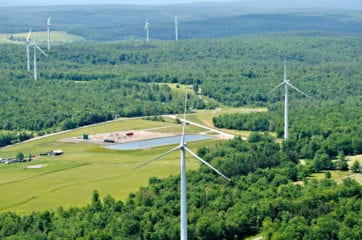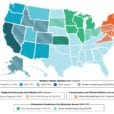Yesterday, Pennsylvania Governor Tom Wolf signed an executive order directing the Department of Environmental Protection to join the Regional Greenhouse Gas Initiative (RGGI). The state’s entry into RGGI marks the program’s largest expansion since its inception more than a decade ago, as well as the first time a major fossil fuel producer will be a part of the initiative.
The move comes after months of debate regarding how the state could utilize market-based mechanisms to reduce greenhouse gas emissions. It nearly doubles RGGI’s regulatory scope, while also signaling to other extractive-heavy states that it is politically feasible to join a carbon market.
Remind me — how does RGGI work?
RGGI is a cap-and-invest program that regulates the electric sector emissions of nine Northeastern and Mid-Atlantic states: Connecticut, Delaware, Maine, Maryland, Massachusetts, New Hampshire, New York, Rhode Island, and Vermont. New Jersey, which was initially in the program but withdrew in 2012, rejoined the program in July. Virginia was also expected to join last year, but failed to when the state’s GOP-controlled legislature included a provision in the 2020 budget prohibiting state dollars from being spent on RGGI.
The program sets a declining annual cap on electric-sector emissions, and allocates allowances to power plants via quarterly auctions. Revenue that is generated in these auctions is invested in energy efficiency, renewable energy innovation, weatherization, electricity bill assistance, and other comparable initiatives.
To ensure that allowance prices are not too volatile, the program includes price control mechanisms; if allowance prices exceed predefined price levels, the Cost Containment Reserve (CCR) triggers the release of additional allowances. In 2021, the trigger price for additional allowances is $13, so if allowances are selling for a higher price than that, more will be added to the bidding pool. On the flip side, if prices are less than established levels ($6 in 2021), the Emissions Containment Reserve (ECR) withholds a number of allowances, removing them from the pool.
How did we get here?
Governor Wolf hesitated to pull the trigger on joining RGGI during his first term, perhaps fearing backlash that could risk his chance at re-election. However, now in his final term as governor, he has been studying the program and ramping up the state’s climate efforts over the past year. Under his leadership, Pennsylvania became the 24th state to join the U.S. Climate Alliance last spring, committing the state to reduce emissions by 80% by 2050.
Governor Wolf is not alone in his desire to push Pennsylvania to lead on climate; several carbon pricing bills have been introduced in the legislature, and the Clean Air Council, a nonprofit air quality organization in the state, filed a petition pushing for an economy-wide price on carbon last year.
That petition, which has been co-signed by hundreds of municipalities, businesses, universities, environmental organizations, and religious groups, calls for the state to implement an economy-wide cap-and-invest program. The Council’s lawyers have maintained the state’s Environmental Rights Amendment, which guarantees the right to clean air, water, and natural resources, provides legal basis for this petition. Advocates say the amendment is particularly powerful in that it is an enumerated part of the state’s Declaration of Rights.
Governor Wolf indicated last spring that he supports a study of the cap-and-trade petition, and in April, Pennsylvania’s Environmental Quality Board (EQB) voted in favor of accepting the petition and studying how an economy-wide program could be implemented. With the Governor’s announcement that the state will be joining RGGI, it’s all but certain that a California-style cap-an-invest program is not in the Keystone State’s near future.
That’s not a huge shock. California is the only US state that has demonstrated the political ability to move onward with carbon pricing without partnership from other states in the region. Even in that case, the state initially intended to launch the program in unison with New Mexico, Arizona, Montana, Nevada, and others.
Joe Minott, the Clean Air Council’s executive director, said that the group is supportive of the Governor’s executive order, but will not be dropping the economy-wide petition.
Could Pennsylvania also be joining TCI?
Pennsylvania may be the first state in US history to implement two different carbon pricing programs at the same time. As it gears up to join RGGI, it simultaneously remains engaged in plans to join the Transportation and Climate Initiative (TCI). TCI, a proposed cap-and-invest program set to regulate transportation sector emissions across nine Northeast and Mid-Atlantic states, is currently in its design phase. Connecticut, Delaware, Maryland, Massachusetts, New Jersey, Pennsylvania, Rhode Island, Vermont, Virginia, and Washington DC all currently on board, but the specifics of the program have not yet been outlined.
The design timelines for these two programs are similar; Pennsylvania’s RGGI rules are due in July 2020, while TCI’s Memorandum of Understanding (MOU) is anticipated to be finalized in the spring of 2020. If the state ultimately joins both of these sector-specific programs, that would undeniably be a huge step in the right direction.
Why does this matter?
The move is particularly significant because it marks the first time a major fossil fuel producer will be a part of the regional initiative. Pennsylvania is the country’s second largest natural gas producer (after Texas) and third largest coal producer (after Wyoming and West Virginia).
Additionally, the entire regulatory scope of the program is set to drastically change. In 2017, Pennsylvania generated 212,754 gigawatt-hours of electricity. For context, the other existing nine RGGI states collectively generated 271,834 gigawatt-hours of electricity.
One thing that may be important to note is how Pennsylvania (and New Jersey’s) entrance affects others in the market. Typically, when new states enter a regional cap-and-invest system, there is political pressure to over allocate allowances at the beginning, which can hurt other state’s goals by throwing off the supply and demand balances of allowances.
Whether or not the program has been effective at reducing emissions is a complicated question; while RGGI states collectively reduced their electric-sector emissions by 47% between 2008 and 2018, cheap natural gas likely played the biggest role in spurring these reductions. At the same time, however, an Acadia Center study found that participating states reduced carbon emissions from power plants at a rate that is 90% higher than the rest of the country.
It remains to be seen what the RGGI implementation timeline will look like for Pennsylvania, but it’s clear that the landscape of the program will drastically change. With yesterday’s executive order, Governor Wolf has sent a strong message to other fossil-fuel extractive states that climate action is urgently needed.










